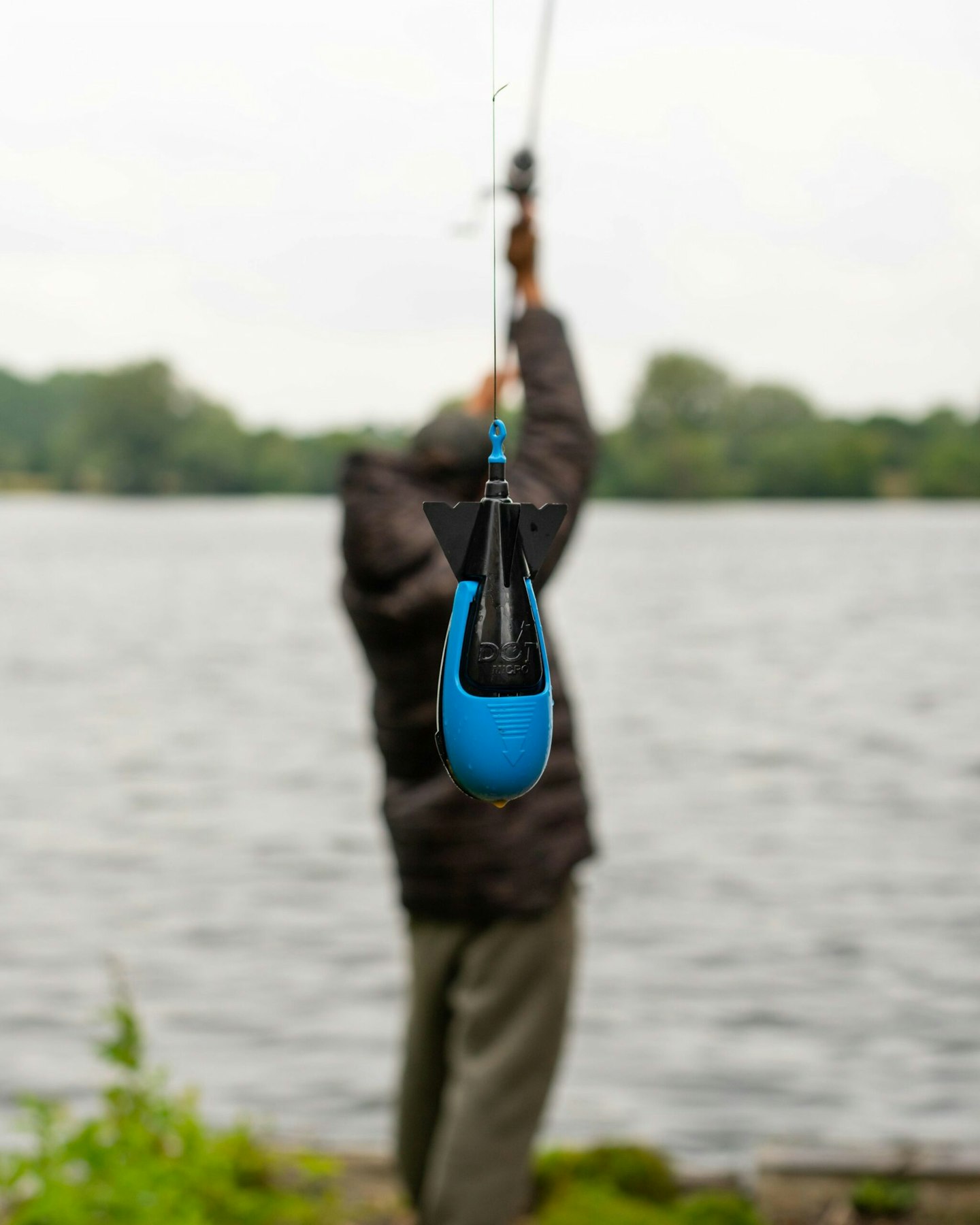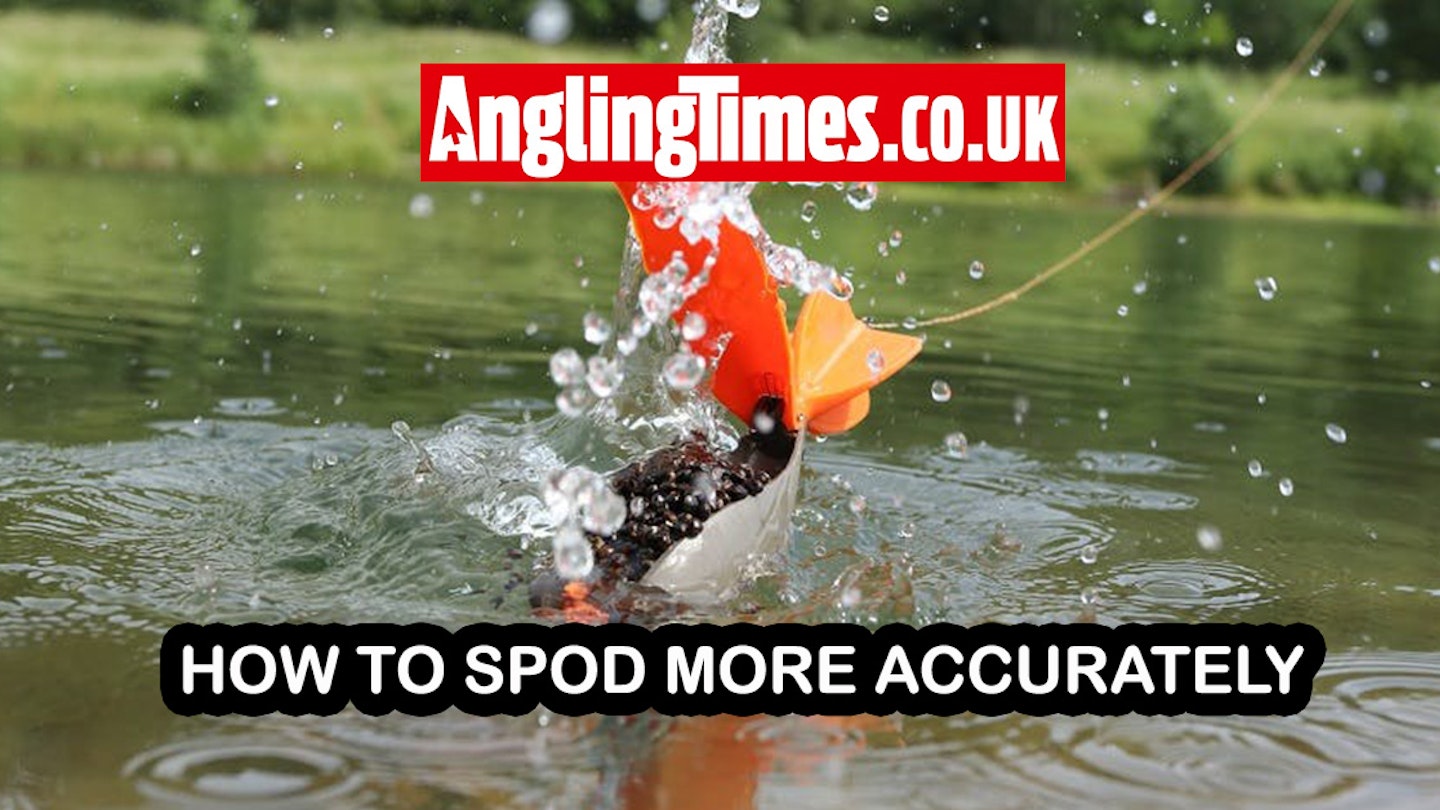One of the questions I get asked probably more than any other is where to clip up the spod rod in comparison to the marker float. Some say leave it at the same distance, whereas others say shorten it by a foot for every 3ft of depth. Now, that’s a significant difference of opinion so I'll delve into what I have experienced underwater.
MAKE SURE YOU ARE USING THE RIGHT ROD BY CHECKING OUT OUR BUYER'S GUIDE TO THE BEST SPOD RODS.

The test
We set up a 1.5m-by-1.5m square box on the bottom of the lake, in 11ft of water 50yds from the bank.
A marker float was cast out to the spot and an Impact Spod was clipped up to the same distance as the marker lead. A filled spod was cast out and, having hit the clip correctly (and this is important), it deposited the bait 3ft behind the target zone. The same test was repeated, and again it fell 3ft ‘too far’.
As usual, I was bedecked in my diving gear watching all this happen underwater, so I then moved the spod until it was touching the marker float on the surface, and asked the lads to clip up once more and try again. This time the bait landed in the box, and it did so again several times when we repeated the experiment.
THE BEST SPODS & SPOMBS WILL ENSURE YOUR BAIT GETS TO THE SPOT AS EFFICIENTLY AS POSSIBLE.

The ‘clipping-up’ conundrum
Having seen that the bait was landing 3ft farther than the marker when the spod was clipped up at the same distance as the marker lead, we then checked the difference between the one he had clipped up and the one I had set ‘bang on the money’.
Our conclusion was that in 11ft of water you could take 3ft off your spod rod line to end up baiting in the middle of your marked spot. Now, don’t be fooled into thinking that this will be 1ft for every 4ft of water depth across the board.
An equally important factor is the distance you are casting, so I would follow the law of diminishing returns. If your water is half as deep again – ie almost 18ft – then I’d perhaps add half again to the amount you take off the spod rod before clipping it up, so I’d take off 4.5ft in total, as opposed to the 6ft it would be if it were a foot for every three.
USING ONE OF THE BEST SPOD REELS WILL MAKE RETRIEVING A SPOMB FAR EASIER.

Consistent casting
I mentioned a moment ago that it was important to hit the clip ‘correctly’, but what exactly does that mean?
Hit it too hard and it will bounce back off the clip, too soft and it will not get to the spot at all. Cast too low and there is again a risk of bounce back, too high and it will be carried by the wind away from the drop zone. So where exactly is the best place to hit the clip?
Ideally the cast needs enough power to get to your chosen spot, and then start dropping. You should be hitting the clip between 2ft to 6ft above the water to get the best and most accurate drop. The lower it hits the clip the further away from you the bait will spread.
The higher you hit it, the more chance there will be of sideways spread as the wind and bow in the line take over. Remember also that bounce back is exaggerated when using braid, as we all do on our spod rods.
It’s easy to think that because you hit the clip that the spod made the distance, but if you hit it too hard and you get a bounce back of 6ft (which may not look a lot from the perspective of the bank) it means that the bait will drop well short of the target.
The key is consistency, and you can check this by looking at how much line you have to reel in before you ‘connect’ with the spod before rewinding to reload. Ideally, you shouldn’t have to reel in any slack at all – you should be in direct contact with the spod on the surface, after it has deposited its load.
FIND THE BEST MAINLINE FOR SPODDING WITH OUR BUYER'S GUIDE TO THE BEST FISHING BRAIDS.

Where do you want your freebies?
It’s important to remember that different people want their hookbait in different places relative to their bait spread. It’s important to remember that proper accuracy and consistency is the key here.
If you cast differently each time, your bait will spread differently. Equally if you are not accurate, your spread will be wide. I can’t emphasise it enough – practise ‘consistent’ casting to take that hugely significant problem out of the equation. Accuracy and keeping bait and rigs tight, without any shadow of doubt, is a key factor in my success.
How bait spreads
So, with the ‘clipping up’ distance covered, the other major thing to consider is how certain baits fall through the water and how far they spread out on the way down.
The mass, size and shape of the bait being fed all come into the reckoning, and certain baits are more suited to certain situations and weather conditions.
Here I’ve compiled a list of the most commonly used types of loosefeed and, based on my observations when diving, how fast they sink and how far they spread.
THERE ARE LOTS OF BAITS YOU CAN USE FOR CARP FISHING, FIND OUT WHAT THE BEST OPTIONS ARE HERE.

Boilies
If they’re round boilies, then they will fall quite quickly and end up pretty tightly grouped on the bottom. The spread in a swim 10ft deep will typically be between 1ft to 1.5ft.
Pellets
Bigger pellets fall more tightly grouped than smaller ones, and in 6ft of water they will spread out by about 2ft, with the heavier ones in the middle and the lighter ones round the edges.
Partiblend
Partiblend, especially hemp, is pretty good at both sinking quickly and offering a decent, even spread as being pre-soaked it’s actually quite heavy so groups up well.
Sweetcorn
Sweetcorn is a lovely bait to spod. It has just the right amount of weight, and it flutters down gently, widening its spread. In 10ft of water it might open up to between 2ft and 3ft, depending on how the spod hits the surface.
Chopped boilies
Chops look lovely on the bank in a bucket, but when they fall through the water they separate out, with the heavier, rounder baits in the middle, and the lighter odd-shaped ones spreading out a little wider.
Six key things to remember
1. Be consistent. The more variation in your casting style, the more variation there will be in your loosefeeding accuracy. This is the golden rule.
2. If you’re struggling to hit the clip, try a bigger Impact Spod. If you’re struggling with accuracy, try a midi-sized one.
3. If you are using an old school spod, bear in mind that it will still be discharging bait until it’s reeled in. When it lands, give it a flick to clear the contents out, rather than letting it drift
4. Different baits fall at different rates. Check the water and weather conditions to make sure you’re not caught out.
5. “A couple of spods” is virtually nothing. I would say most anglers should double the amount of bait they are putting in to achieve what they think they are doing.
6. Boilies fed via a Spomb/Impact Spod tend not to spread out. If you want a wider spread, use a catapult, or put a lot less in and make more casts.
WANT TO START CARP FISHING? OUR BEGINNERS GUIDE HAS SOME GREAT ADVICE ON HOW TO START.

This page is a free example of the amazing content Angling Times Members get every single week. Becoming an Angling Times Member gives you access to award-winning magazine content, member rewards, our back issue archives, bonus content and more! Join our fishing community and find out more today!
